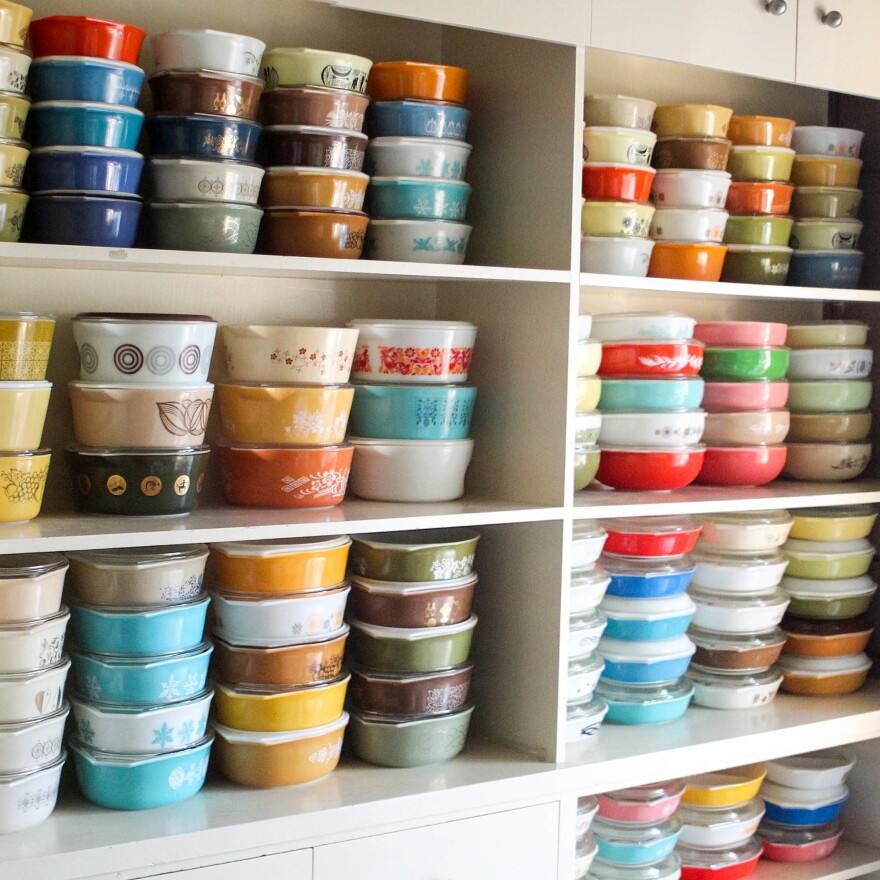In 1915, an advertisement proclaiming, "Bake in a glass!" appeared in the pages of Good Housekeeping. Corning Glass Works in New York had created a product that allowed food to be mixed, baked and served all in the same dish. By 1919, 4 million pieces of Pyrex — a new, durable glassware — had been sold to customers throughout the United States.
Compared to modern kitchen items, vintage Pyrex — which is heavy, increasingly expensive and not dishwasher safe — doesn't seem immediately practical. Yet people remain obsessed with the old Pyrex — not just to look at but to actually use.
Michael Barber, author of the Pyrex Passion blog and guides to various patterns and colors of the dishware, started thinking about vintage Pyrex while helping his mother clean out her house. "She had some bread making bowls she was getting ready to donate," he said. He remembered her baking with the pieces during his childhood. He took them home instead, later discovering that they had first belonged to his grandmother — he was the third generation to use them.
"I went online to find the rest of the set and got lost in the world of all the opal Pyrex patterns and designs," Barber says. "I thought they were so beautiful and we don't have anything like that these days."

Though the earliest Pyrex was made of clear glass, in 1947 Corning debuted a set of different-sized colored mixing bowls that could nest together like Russian dolls to save space. They were made out of soda lime opal glass, which had originally been used in military cafeterias. Pearl white on the inside, the outsides of the four-bowl set were each yellow, green, red and blue. My grandma had a set — your mother or grandmother likely did, too. Pyrex was already popular, but these color bowls created a legacy.
"It was the combination of the affordability of it and the fact that there was some effort to tailor it to what people needed," explains Regan Brumagen, one of the curators of the ' Pyrex exhibit, which ended in 2016. "I'm not just talking about in terms of efficiency but also psychologically." After World War II, Americans were ready to fill their lives — and kitchens — with cheerful colors and kitsch.
From the very beginning, Pyrex was a product for women designed by women. Though a male Corning scientist developed the technology for a glass that could withstand quick changes in temperature, it was his wife, Bessie Littleton, who suggested it be applied to kitchenware. She baked a sponge cake in a sawed-off jar to prove her point.
As Pyrex began to take off, female home economists were hired by Corning to research, test and promote new versions of the product. Lucy Maltby, who initially ran the company's consumer services office, ended up creating a test kitchen that was designed to anticipate consumer needs before they were even requested: handles big enough to grip without burning your hands and mixing bowls sized to fit cake mixes of the time so the batter didn't spill over.
Barber's collection eventually expanded to include every piece of opal Pyrex ever made. He guesses he has roughly 4,000 pieces scattered throughout his home. In contrast, Kristina West's collection of more than 300 pieces seems small, but she's no less passionate. She is the admin of the Facebook group "Pyrex Passion," which has nearly 17,000 members. She also started a Pyrex swap in her home state of Tennessee where collectors could meet and exchange tips and vintage Pyrex. She says it's now the largest swap in the United States.
"I'm always surprised by the number of people collecting that didn't know how many others were out there," she says. "It's like their secret shame." With the Internet, Pyrex collectors have become more public and for many, connecting over Pyrex is a way to meet new friends. It's impossible to avoid vintage Pyrex — Instagram and Pinterest are overflowing with photos of kitchens dotted with Pyrex or display cabinets filled with matching dish sets.

People who walk into Morgan Mancha's house for the first time can't avoid noticing the Pyrex on display in nearly every room of her house. She lives in a mid-century modern home in Riverside, Calif., and started collecting the kitchenware when she was searching thrift shops to find dishes that would match her home. Mancha now has more than 3,000 pieces, enough that she can't possibly keep everything on display despite her four Pyrex-filled hutches.
Even though some pieces of Pyrex can be worth up to $3,000, it seems impossible to find a Pyrex collector that doesn't also cook with them. For people worried about making food in plastic containers, glass Pyrex is relatively clean and the vintage pieces are American made. (The modern ones are, too.) And while they're old, they're also surprisingly durable.
"I tend to have a heavy hand in the kitchen," Mancha says. "I break things, but when I drop Pyrex bowls, they bounce back up again." One famous Pyrex ad shows someone dropping Pyrex from a ladder without breaking when it hits the ground.
It's inevitable that the current mid-century modern craze will eventually end, but collectors don't believe the Pyrex will disappear along with it. "I think it will always remain collectible, just because of the durability of it," says Barber. "These bowls can be carried on through five generations and still look as good and be as useful as they were 100 years ago."
Tove K. Danovich is a journalist based in Portland, Ore.
Copyright 2021 NPR. To see more, visit https://www.npr.org. 9(MDAxNzg0MDExMDEyMTYyMjc1MDE3NGVmMw004))








